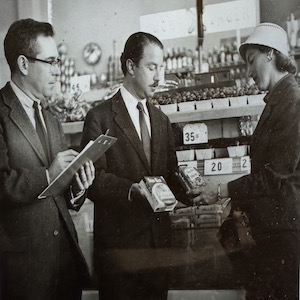Transatlantic Perspectives: Europe in the Eyes of European Immigrants to the United States, 1930-1980
Transatlantic Perspectives: Europe in the Eyes of European Immigrants to the United States, 1930-1980 is an online history research project created by The German Historical Institute in Washington D.C. The project traces transnational entanglements, European influences on American society, and multidirectional transfers that complicate narratives of postwar “Americanization.” The project aims to uncover the ways in which migrants helped shape the Cold War Atlantic Community and numerous aspects of American and European life from politics and the arts to the sciences and mass consumption.
The project is well-designed, easy to use, and rich in content. The home page lists nine sections at the top of the screen: "Home," "About," "News, "Transatlantic Careers," "Transnational Institutions," "Transatlantic Perceptions," "Topics," "Objects" and "Resources." The core contents of this project are scattered in "Transatlantic Careers," "Transnational Institutions," and "Transatlantic Perceptions." "Transatlantic Carees" provides the biographies, as well as the related photos and documents of 65 famous European immigrants, such as Hannah Arendt (the political theorist), Thomas Mann (novelist, anti-fascist intellectual), and Walter Gropius (founder of the Bauhaus art school). "Transnational Institutions" introduces 23 transatlantic institutions and networks that facilitate transfers, which defined by the website as the import or export of ideas, methodologies, or practices across national or cultural boundaries. By offering users a series of primary sources which extracted from newspaper accounts or magazine, "Transatlantic Perceptions" show the mutual perceptions of Europe and the United States during the second half of the twentieth century. All three sections provide a wealth of primary source material—both documents and visual sources to users, including letters, reports, yearbooks, manuscripts, lecture press, memorandums, and photos. Users can also search the resource by different themes under the "Topic," from business, consumer design, to urban planning. However, the biggest disadvantage of this project is all of the introductory articles under each section are unavailable; the website shows "There has been a critical error on this website." The reviewer really hopes the creation team spend some time to figure it out in the future.
What role did European immigrants and émigrés play in shaping transatlantic networks of exchange between the United States and Europe during the middle of the twentieth century? After exploring Transatlantic Perspectives, we may have answers in our minds. When using this project as a teaching tool, teacher may also let students to think about some questions: To what degree was the much discussed “Americanization” of postwar Western Europe tempered by a continued influence of European ideas and voices on transatlantic relations in a variety of fields? What role did immigrants and returning émigrés play in transnational processes of transfer and exchange in postwar Western Europe? By contextualizing the migrants and their professional biographies within the wider world of transatlantic relations and the mutual perceptions of Europe and the United States of America during the second half of the twentieth century, this project draws attention to the transnational institutions and networks that facilitated transfers and exchanges between Europe and the United States. Another value of this project is it points out that elite migrants played a significant role in shaping the Cold War world. As intellectuals, academics, policy advisers, and political activists, they informed American views of Europe, its political “totalitarianisms,” and its potential for economic and cultural reconstruction after the war. As returning émigrés, they similarly brought an American perspective to postwar European societies, acting even—in some ways—as agents of “Americanization.” Transatlantic Perspectives, thus shows that transatlantic history during the American century was in fact characterized by a complicated entanglement of social, cultural and economic developments in Europe, and the United States.
